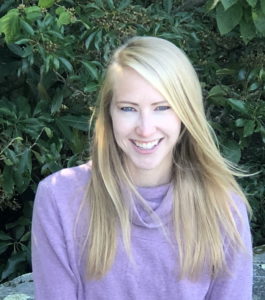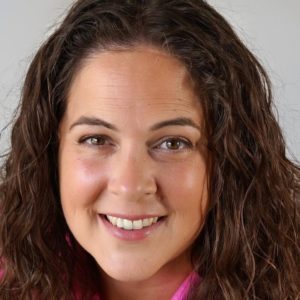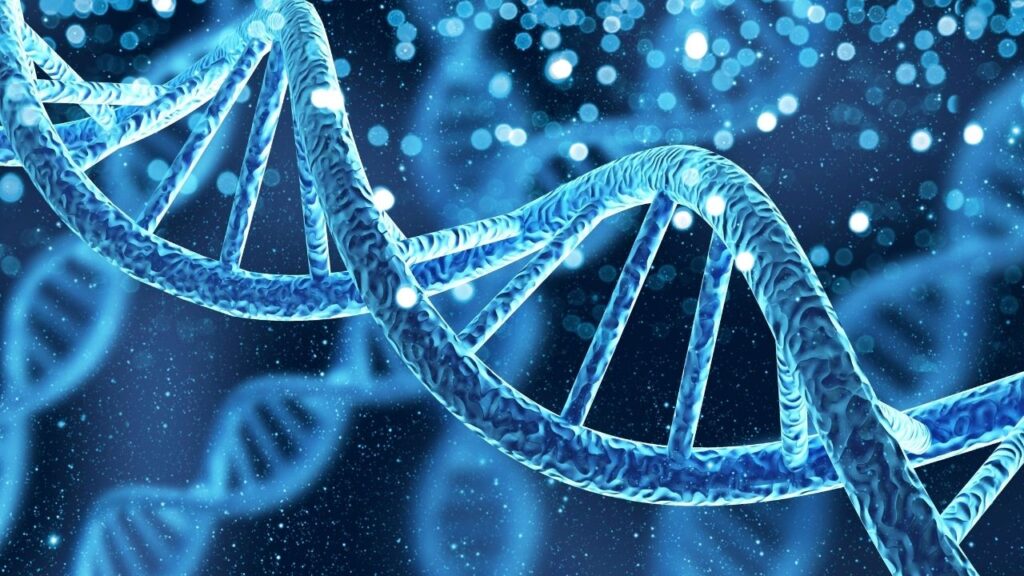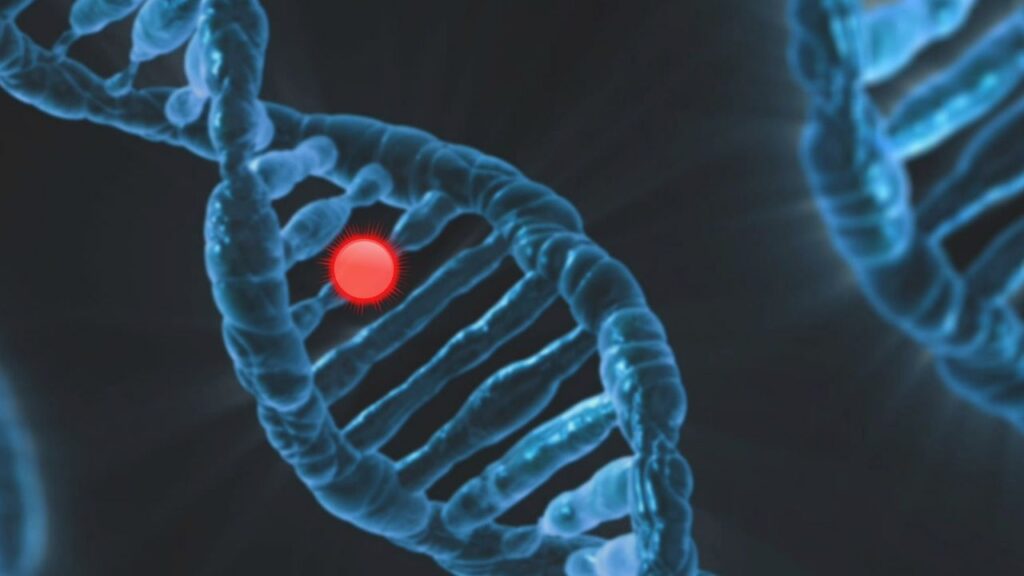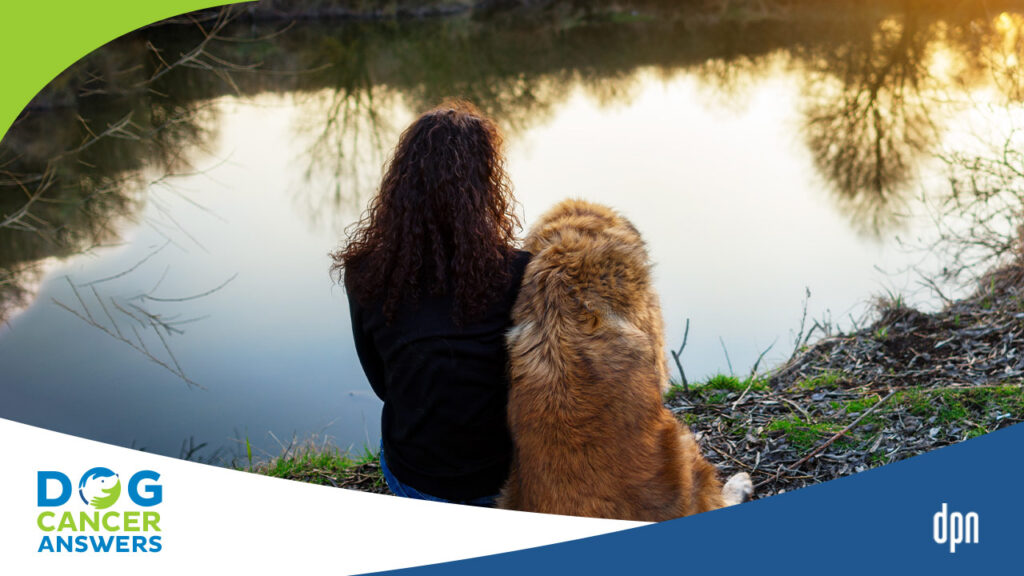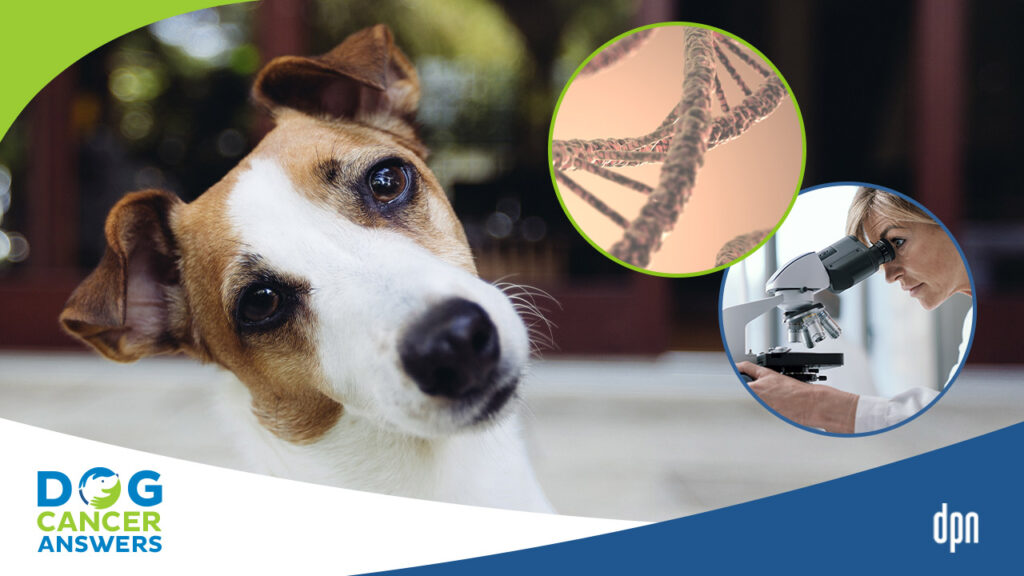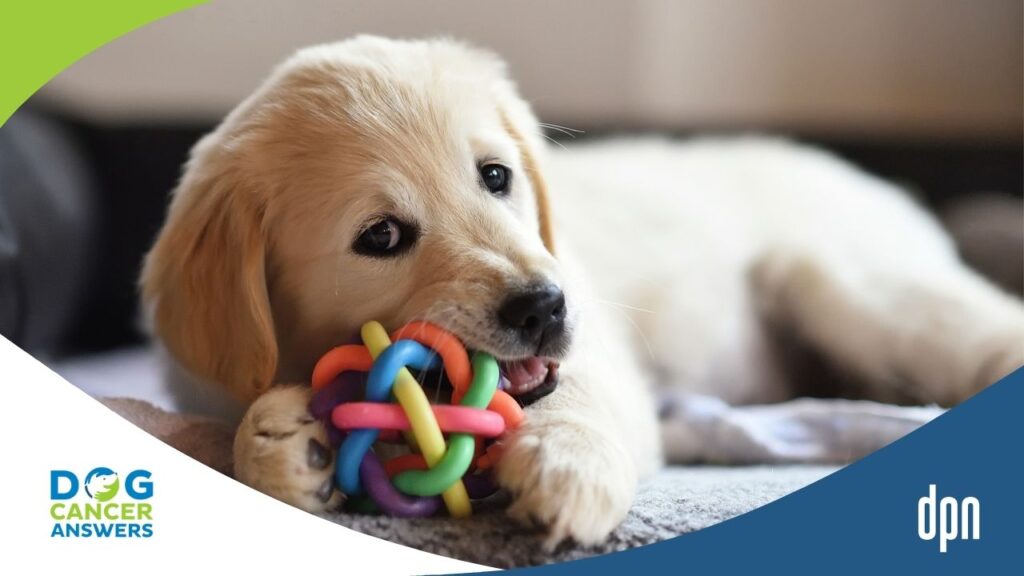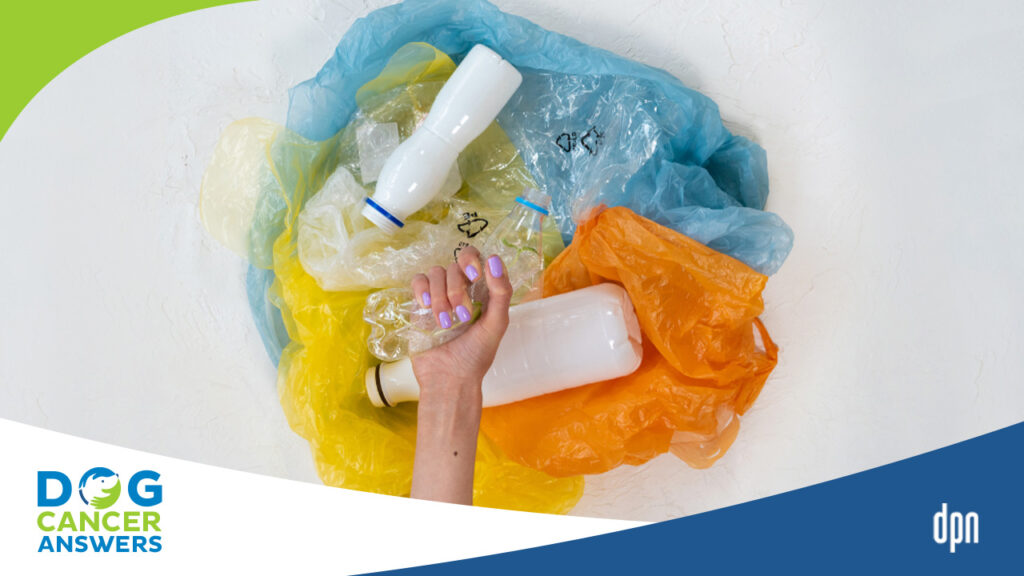EPISODE 224 | RELEASED July 24, 2023
How Do Genetic Mutations Cause Cancer? | Dr. Charlotte Hacker
There are many dog cancer causes, but genetic mutations are at the root of each case. Learn what these microscopic errors are and how they can lead to cancer.
SHOW NOTES
Your dog has trillions of cells, each one containing DNA with about 19,000 genes. Every day, cells die and are replaced by new ones after copying their genetic material… and sometimes those copies include mistakes.
Charlotte Hacker has a deep love of genetics, and explains the basics of how genetics work and how mutations can occur. Not all of these mistakes are harmful, but a mutation in the wrong spot or a buildup of multiple mutations can lead to cancer.
Listen now to learn about proto-oncogenes, tumor suppressor genes, why bigger dogs are more likely to get cancer, and how you can help support the health of your dog’s DNA.
Links Mentioned in Today’s Show:
Genetic Mutations and Dog Cancer: An Overview (article) https://www.dogcancer.com/articles/stats-and-facts/genetic-mutations-and-dog-cancer/
Related Links:
Genetics in Canine Cancer article
SearchLight DNA Can Find Your Dog’s Cancer Genotype podcast episode
Sunshine for Dogs article
[00:00:00] >> Dr. Charlotte Hacker: DNA polymerase is the little guy that’s kind of driving along the DNA that’s replicating it or copying it so that the cell can split into two. And it hits that road bump and it might copy it wrong because now it’s run into something that’s messed up with the original DNA strand in it.
[00:00:19] >> Announcer: Welcome to Dog Cancer Answers, where we help you help your dog with cancer.
[00:00:25] >> Molly Jacobson: Hello friend, I’m Molly Jacobson. Today on Dog Cancer Answers, we’re talking about the very beginning of how cancer starts: with genetic mutations. Understanding what genetic mutations are is useful because we can find strategies to prevent and treat cancer when we know them. In fact, there is a lot of cancer research being done right now to identify specific mutations that cause specific cancers and then develop treatments to target them.
To explain this kind of complicated subject, we’re joined by returning guest, Dr. Charlotte Hacker. Dr. Hacker is a geneticist by trade and very good at explaining how genetics plays a role in dog cancer.
So Dr. Charlotte Hacker, thank you so much for joining us again to talk about your specialty.
[00:01:14] >> Dr. Charlotte Hacker: Of course.
[00:01:14] >> Molly Jacobson: Genetics.
[00:01:15] >> Dr. Charlotte Hacker: Yes. My favorite.
[00:01:17] >> Molly Jacobson: Literally your favorite.
[00:01:18] >> Dr. Charlotte Hacker: Literally my favorite. I spent a long time studying it, so I’m, I’m pretty invested.
[00:01:24] >> Molly Jacobson: Well, that’s why we’re having you on. And that is why we asked you to write some articles for dogcancer.com on this subject. It’s a little wonky for the average dog lover, of course. The big question that we have that we’re hoping we can get sort of answered in this show, I know there’s a million details to follow, but why do dogs get cancer?
[00:01:46] >> Dr. Charlotte Hacker: Oh, gosh. A can of worms, I guess. Genetics is, is really kind of a foundation, you know, these genes that make up your dog’s genome. Pretty complex and yet beautifully simple at the same time, which is one of the reasons why I enjoyed studying genetics so much.
But dogs in particular have a very kind of, a few unique differences in terms of their risk with cancer and genetics because we as humans have artificially, you know, chosen certain physical traits and and have bred them and kind of very quickly changed them. You know, genetically, all dogs, regardless of breed, are almost identical, which is crazy to think of, right? You have Great Dane and my dog, who’s, you know, 10 pounds. They have almost the same exact kind of genetic makeup.
[00:02:34] >> Molly Jacobson: Okay.
[00:02:35] >> Dr. Charlotte Hacker: You know, your domestic kind of family dog wasn’t genetically separated from wolves until, you know, relatively recently, which is kind of crazy to think about. They’re still kind of considered more of a, I guess, subspecies, if you want to think of it like that. And so, you know, we’ve really manipulated the genetics in dogs, which also means that we’ve kind of manipulated their cancer risk and what kind of cancers that they get.
[00:03:00] >> Molly Jacobson: Oh.
[00:03:00] >> Dr. Charlotte Hacker: Yeah.
[00:03:01] >> Molly Jacobson: Okay.
[00:03:02] >> Dr. Charlotte Hacker: Mm hmm.
[00:03:04] >> Molly Jacobson: All right. Another example of humans trying to do something good and ending up maybe doing something with unintended consequences.
[00:03:13] >> Dr. Charlotte Hacker: Yeah. And it, you know, it varies by the breed and it’s not always predictable, right? Genetics is, like I said kind of earlier, that it’s super complicated. And some things we just, we still don’t understand well enough to even, to even know, I guess, what, what the outcomes may be from the way that we’ve bred dogs or the breeds that we, you know, use for specific jobs that are really beneficial to humans and things like that.
[00:03:35] >> Molly Jacobson: Okay.
[00:03:36] >> Dr. Charlotte Hacker: Yeah.
[00:03:36] >> Molly Jacobson: All right. So the bottom line is dogs get cancer for lots of reasons, but they all end up coming down to how they influence, it seems, the genetics in the dog.
[00:03:48] >> Dr. Charlotte Hacker: Yeah. So we can start, we’ll kind of start, I guess, at the building blocks. So your dog is composed of trillions and trillions of cells, as are we. And in each of these cells is DNA. And DNA, you can think of as an instruction manual or a blueprint for a house. DNA is the reason your dog looks the way it looks, acts the way it acts, and also why it has the cancer risk that it has.
[00:04:14] >> Molly Jacobson: Okay.
[00:04:14] >> Dr. Charlotte Hacker: And DNA, going back to genetics being beautifully simple in some ways, is made up of four building blocks. We call them nucleotides. They’re denoted by the letters A, C, T, and G, and they have fancier names, but we’ll just stick, stick to the letters for now.
[00:04:31] >> Molly Jacobson: Let’s stick with the letters, yeah.
[00:04:32] >> Dr. Charlotte Hacker: And those letters, I think it’s probably easiest to, in this example, think of them as going linear, kind of in an alphabetical, like how the alphabet is linear, but these four letters are composed into various combinations and, and repeats. So you might have like A, A, T, G, C, T, G. And stretches of those letters make up genes. And those genes code for proteins that do jobs in the cell.
So not, don’t think of proteins like what you eat, but think of proteins as kind of like, I like to think of them as kind of like these little worker bees that kind of go around the cell and they’re signaling that the cell needs to do this or needs to do that.
And so the DNA is really kind of like the starting point that dictates everything that happens in the body because it ultimately makes these proteins that are doing all of the jobs in the cell necessary for the body to function and the kind of intermediate part of that is that DNA operates in threes. So it’s called a codon, so within each gene – and dogs have about 19, 000 genes.
[00:05:42] >> Molly Jacobson: Oh my gosh.
[00:05:43] >> Dr. Charlotte Hacker: We have between 20,000 and 25,000 and these genes code, you know, for everything and, and some genes only code for one particular thing. Other more complicated things like height, for example, you have many genes that work together that determine how tall you are or how big your dog is.
[00:06:00] >> Molly Jacobson: Okay.
[00:06:00] >> Dr. Charlotte Hacker: But these genes, in general, we all know what they do. We’ve been able to sequence the entire genome of a lot of animals, so all of the genetic information that is in that entire huge blueprint, you know, we know that for dogs.
[00:06:16] >> Molly Jacobson: Okay.
[00:06:16] >> Dr. Charlotte Hacker: The blueprint is actually a Boxer. That was the first dog that we did that on.
[00:06:21] >> Molly Jacobson: Oh.
[00:06:22] >> Dr. Charlotte Hacker: We, I didn’t do it, but the geneticist did that on. And some DNA we have, you know, it codes for genes, we have no idea what it does. We call it junk DNA. And so it’s still a bit of a, a mystery, but for the most part, you know, you’ve got DNA that makes up these genes and DNA works in threes to make what we call codons.
So you might have A, T, and C that collectively functions as what we call a codon and that codon makes a particular amino acid. That amino acid – there’s 20 different ones –
[00:06:57] >> Molly Jacobson: My goodness.
[00:06:57] >> Dr. Charlotte Hacker: -then kind of comes along to make the protein. So there is a bit of like an intermediate. So what the DNA codes for in terms of the amino acid is important because that amino acid is eventually going to work with other amino acids in that gene to make the protein.
[00:07:13] >> Molly Jacobson: Okay.
[00:07:14] >> Dr. Charlotte Hacker: So genetics is, can be a little bit tricky because that sequence, that DNA sequence, it can change. And if it changes, then you potentially could have a different protein that’s made, or that protein is not made at all, or that protein works a little too well, and that’s when you start to get things that go a little bit, potentially, funky in terms of the function that that protein should be doing, which can have large scale ramifications like cancer depending on what gene that particular change happens in.
[00:07:47] >> Molly Jacobson: So to expand on the blueprint idea, if I’m looking at a blueprint of a house-
[00:07:52] >> Dr. Charlotte Hacker: Yes.
[00:07:53] >> Molly Jacobson: -then I might see part of the blueprint will just look at the actual timber frame, the framing, the, the structure. Other parts of the blueprint will show the electrical. Other parts will show the plumbing. Other parts might show like an air conditioning system that is in the wall. So you see all of these different systems and if there’s a problem in the blueprint, like say the builder for the house looks at the blueprint and there’s a certain pipe that has to go through a certain area and it needs to have a junction that goes in another place.
If they don’t fit that exactly right, and there’s a little bit of a leak left there, or there’s a little bit of a weakness in the fitting for that pipe so that water could escape eventually – it holds tight to begin with, but maybe it’s just a little bit of a hair’s breadth off. And eventually that works out, now you’ve got a possible leak. Then you do have a leak over time and that leak will not just affect the pipe.
It’ll affect the insulation that’s nearby, possibly the electrical system. It’ll get into the wood in the structure. It might attract mold. There’s all sorts of things that can cascade from that little bit of a mutation in that fitting, right? Like you’ve got the perfect blueprint, but the blueprint was just a little bit like, there’s a little mistake that the architect made when they, they said, do this here, and it wasn’t quite the right choice or not the perfect choice, the ideal choice. There’s cascades that might not show up for years and years and years. How am I doing?
[00:09:34] >> Dr. Charlotte Hacker: I think the idea of there being like downstream effects, that’s really, really, that’s a great example for that. The blueprint, I guess you could think of it in two different ways, because the architect could have like kind of screwed something up to begin with, or maybe somebody erased something that they didn’t mean to, or yeah, like there’s so many other things that can go wrong in that process for that pipe to not fit right. But you’re right.
[00:10:00] >> Molly Jacobson: Somebody spills like a little drop of water-
[00:10:02] >> Dr. Charlotte Hacker: Exactly.
[00:10:02] >> Molly Jacobson: -on the blueprint and then it looks like the architect did this, but they can’t see that it’s actually water damage on the blueprint.
[00:10:10] >> Dr. Charlotte Hacker: Yeah.
[00:10:10] >> Molly Jacobson: Okay.
[00:10:11] >> Dr. Charlotte Hacker: Yeah.
[00:10:11] >> Molly Jacobson: So this is really interesting. So lots of things can happen to that blueprint. The blueprint could be wrong from the beginning, or it can be good, but then something can change it.
Let’s take a short break. And then when we get back, I want to talk about the types of mutations that can occur.
And we’re back with Dr. Charlotte Hacker talking about how genetic mutations cause dog cancer. So mutations that happen to DNA are?
[00:10:40] >> Dr. Charlotte Hacker: They can either be hereditary or they can be spontaneous. And mutations are just changes in the DNA sequence that happen. And it’s something that, you know, it’s a pretty normal process. So you might have a DNA sequence that is, you know, A, T, G, G, C, and there might be a mutation where part of that gets deleted. Something comes in and gets added. Maybe something, you know, one little nucleotide or like an A gets switched out for a T.
And where that happens is important because which gene it affects is important in terms of those downstream effects. So where in the blueprint of the house you make this mistake can have bigger consequences than other parts of the house, right? If it’s hereditary, that means that it happens in a germline cell or in a sex cell.
So you can have a mutation that happens in the DNA of an egg from your mom or sperm from your dad. So you actually have two copies of DNA. So you have a copy from your mom and a copy from your dad. And so you have these two sets of DNA that kind of work together to make you who you are. And when those two sets are put together, there can at times be mutations that are passed on because they were in a sperm cell or because they were in the egg that then you get. That’s hereditary.
Spontaneous are the ones that just happen during life, in every other cell in your body. So somatic cells are basically everything else that your body is made of that isn’t sperm or an egg, depending on your sex.
[00:12:04] >> Molly Jacobson: Okay.
[00:12:04] >> Dr. Charlotte Hacker: And those mutations, there’s several different kinds and they happen for a lot of different reasons. So, spontaneous mutations are just… They happen during life. They’re somewhat inevitable. There are certain things that are more likely to cause them than others. But typically, you know, you might have – so, for example, one of the big ones that happens is like UV light. We talk about UV light all the time.
And I’m sure you in Hawaii think about it pretty often, right? It’s a, it’s a concern. That UV light is actually beating down on the DNA in your cells. And it causes what’s called thymine-thymine dimers, which are just two of those T’s that get stuck together.
[00:12:39] >> Molly Jacobson: Ah.
[00:12:40] >> Dr. Charlotte Hacker: And your cells are constantly growing and dividing and dying, right? They have their own process for that. It’s extremely important. And that DNA during that process needs to replicate, right? Because you’re going to go from one cell to two daughter cells during that process. And that DNA needs to replicate so it can split into two daughter cells. And that thymine-thymine dimer kind of becomes a road bump.
So the DNA is like driving along, and DNA polymerase is the little guy that’s kind of driving along the DNA that’s replicating it or copying it so that the cell can split into two.
[00:13:13] >> Molly Jacobson: Okay.
[00:13:13] >> Dr. Charlotte Hacker: And it hits that road bump and it might copy it wrong because now it’s run into something that’s messed up with the original DNA strand in it. Now, the daughter cells have that mutation, right? So the DNA doesn’t get replicated correctly, that’s a big source of mutations. And replicating happens constantly, it’s constant, and every once in a while, your body’s going to screw it up. And it’s relatively, you know, normal. You have trillions of cells that are constantly going through this cell cycle.
When that DNA gets replicated, it doesn’t do it right, you can get a mutation. You can also get a mutation from different outside factors. So you can have toxins that come along and break the DNA. DNA is a, a strand more or less. It can literally break it. That can cause issues when the cell goes to divide. And you can have mutations that are, you know, like I said, hereditary and they just kind of exist and, and that may be problematic. It may not. Mutations are not always bad. But I think we often think of them as bad.
[00:14:17] >> Molly Jacobson: Yeah. Because we call mutations and in popular culture, a mutant is, you know, in the, it is something that is outside the normal and not necessarily good. Although depending on which universe, which comic book you’re reading-
[00:14:32] >> Dr. Charlotte Hacker: That’s true.
[00:14:32] >> Molly Jacobson: -they could be the heroes. Yeah.
[00:14:36] >> Dr. Charlotte Hacker: Mutations can sometimes be beneficial or they may not have any effect at all. And so there are mutations, for example, where the same protein ends up getting made, even though the DNA sequence becomes different. So it doesn’t really matter. And there are mutations where a different protein gets made, but it works way better at the job that it was meant to do. Or you may have a mutation that completely alters what that protein does, or the protein doesn’t work as well, or it works too well. And then that can cause issues as well.
One of the big things that I think is the easiest example is a lot of traits for sexual selection. So birds, for example, or elephants and their tusks, eventually, right, there was a bird that had a mutation that made its feathers bigger or its feathers more blue, if you want to think of a peacock, and females found that more attractive.
So that ended up benefiting that male, right? Because it was able – when you’re an animal in the wild, you just want to reproduce, right? So it helps you to pass on your genetics, which is kind of your drive as an animal. And so it may have been a mutation and now that mutation becomes more prevalent in a population, the peacocks, and subsequent generations in that population become more blue.
And, you know, there, there are all sorts of examples. And sometimes that can swing the opposite way and, you know, go back to a status quo. It all just kind of depends on this idea of natural selection and what, what aids you in passing on your genetics as an animal.
[00:16:00] >> Molly Jacobson: Okay. So we don’t have to worry that, oh, my dog has a mutation, therefore, my dog is going to get cancer.
[00:16:06] >> Dr. Charlotte Hacker: Not necessarily.
[00:16:07] >> Molly Jacobson: Okay.
[00:16:07] >> Dr. Charlotte Hacker: It all kind of depends on what gene it’s in as well.
[00:16:10] >> Molly Jacobson: Okay.
[00:16:10] >> Dr. Charlotte Hacker: Yeah.
[00:16:10] >> Molly Jacobson: So that brings us to, I think, oncogenes.
[00:16:13] >> Dr. Charlotte Hacker: Yes.
[00:16:14] >> Molly Jacobson: Which, onco means cancer.
[00:16:16] >> Dr. Charlotte Hacker: It does. It’s not a good word.
[00:16:18] >> Molly Jacobson: So cancer genes. Let’s talk about cancer genes. That sounds scary.
[00:16:22] >> Dr. Charlotte Hacker: Sure. Um, a little bit. So we were talking about the cell cycle a little bit earlier, and all cancer is is unregulated cell growth. So cells are constantly growing and dividing, super important process. And because it’s so important cells are actually really good at it. They make sure they do it right. You can almost think of cells as like like Nervous Nellies before they divide. They’re constantly checking in and then, you know, asking Am I good?
Should I do this? Am I healthy enough? Do I have the right genetic material? And there are genes that code for proteins that are responsible for those checkpoints. And so every protein has a job and some of those proteins act as like little signals and the cell says, okay, I am good to go, or the cell might say, not so much, maybe I shouldn’t divide, I’ve got this funky thing going on in my DNA, and I’m not going to bother. I’m just going to go ahead and go into apoptosis, or cell death, very normal thing that cells will do.
And so there are these checkpoints throughout the cell cycle, different genes are responsible for that cell cycle to occur, and often those particular genes are what we consider proto-oncogenes. So they’re genes that have the capability, if they are mutated, to result in cancer. If they are mutated or become mutated, then they become oncogenes. So, sometimes you see those two things used interchangeably, but there is a slight difference.
[00:17:45] >> Molly Jacobson: Proto meaning before.
[00:17:47] >> Dr. Charlotte Hacker: Yes. Yep.
[00:17:48] >> Molly Jacobson: Before oncogenes. So, these are genes that all of us have that are involved in replication of the cell.
[00:17:55] >> Dr. Charlotte Hacker: Yes.
[00:17:56] >> Molly Jacobson: Okay.
[00:17:56] >> Dr. Charlotte Hacker: Yep.
[00:17:57] >> Molly Jacobson: So, having a proto oncogene does not mean that you’re going to get cancer. It means that you are a normal person who has cells that live and will divide and grow. And your dog has a lot. We all have proto-oncogenes.
[00:18:10] >> Dr. Charlotte Hacker: We do. Yes. We need them.
[00:18:11] >> Molly Jacobson: Okay.
[00:18:11] >> Dr. Charlotte Hacker: Yeah. It’s a good thing that you have.
[00:18:12] >> Molly Jacobson: We need proto-oncogenes.
[00:18:14] >> Dr. Charlotte Hacker: Yeah.
[00:18:14] >> Molly Jacobson: Yeah. They’re compatible with life.
[00:18:15] >> Dr. Charlotte Hacker: Yes. Yeah. They are.
[00:18:17] >> Molly Jacobson: Okay.
[00:18:17] >> Dr. Charlotte Hacker: Yeah.
[00:18:18] >> Molly Jacobson: Okay. So if one of those genes happens to get a mutation and stops working correctly, then the replication process is interfered with and possibly accelerated or doesn’t stop or the cell lives forever.
[00:18:34] >> Dr. Charlotte Hacker: Yeah.
[00:18:34] >> Molly Jacobson: And that’s when they have turned into oncogenes, which is cancer genes.
[00:18:38] >> Dr. Charlotte Hacker: Right. So, and just because it is mutated and becomes an oncogene doesn’t necessarily mean it will result in unregulated cell growth.
[00:18:46] >> Molly Jacobson: Okay.
[00:18:47] >> Dr. Charlotte Hacker: You know, more than one mutation can happen in one gene. And so some genes need to have like a whole suite of mutations happen before it gets to the point where they like step on the gas and now the cell can’t regulate itself. And then you also have tumor suppressor genes, which kind of on the opposite side of that are telling the cell cycle to kind of slow down and checking in and saying, you know, do you need to divide? Is this really necessary? And it’ll kind of halt that replication.
And so that’s also at play too, can also be mutated. And then if that’s the case, those tumor suppressor genes may not work at all, and then you’ve got nothing stopping the cell cycle or, you know, telling it to go through that, you know, ask itself that question, am I okay to divide? And then you have a similar outcome in that the cell still divides even though it shouldn’t. So you kind of have these two sides of the spectrum that can result in cancer.
[00:19:39] >> Molly Jacobson: So the cell has its own checklist it goes through to make sure that it’s safe to divide and then there’s tumor suppressor genes that also say, Are you okay to divide?
[00:19:48] >> Dr. Charlotte Hacker: Yeah.
[00:19:49] >> Molly Jacobson: So there’s like two – that’s really, I love the idea of cells being Nervous Nellies and-
[00:19:55] >> Dr. Charlotte Hacker: Yeah. Because if they’re not, the ramifications are huge, right? Cells want to live, you know, until they can’t.
[00:20:00] >> Molly Jacobson: They don’t want to die.
[00:20:01] >> Dr. Charlotte Hacker: Yeah. So they.
[00:20:02] >> Molly Jacobson: They don’t want to become cancer.
[00:20:03] >> Dr. Charlotte Hacker: It does not behoove them, yeah, to go haywire. And, and that’s kind of where dogs become a little bit of an, an issue or make it a little bit more difficult with cancers because typically every cell has the same likelihood or chance of becoming a cancer cell and being unregulated, going haywire. So you would think that the larger the animal, the more likely it is to get cancer. But species like elephants and blue whales almost never get cancer.
[00:20:32] >> Molly Jacobson: Really?
[00:20:33] >> Dr. Charlotte Hacker: Almost never.
[00:20:34] >> Molly Jacobson: Huh.
[00:20:34] >> Dr. Charlotte Hacker: And we’re finding that that’s because they make a ton of a tumor suppressor gene called p53, and they are just constantly pumping it out. And so they constantly have this protein that’s like, hey, like, don’t do that. Don’t divide. Or, you know, you should die. And it’s constantly, like, making that at a higher level to keep up with the number of cells that that animal actually has. And that’s something that nature has built in to the system through time, through natural selection.
Dogs didn’t have that opportunity because we took them and we bred them very quickly. And so that’s why bigger dogs are more likely to get cancer than smaller dogs. It’s a concept called Peto’s Paradox and that’s kind of where genetics and dogs and cancer gets, you know, those little nuances are like, oh, this becomes a little more complicated, right? Because we have messed – maybe not messed – we’ve altered the genetics of dogs to an extent where those kind of tried and true principles that we’ve learned about don’t necessarily hold true.
[00:21:32] >> Molly Jacobson: Well, that is really fascinating. My mind is now just spinning around thinking about everything you just said. Um, how can we prevent mutations from happening in our dogs?
[00:21:45] >> Dr. Charlotte Hacker: It’s a really good question. Spontaneous mutations that happen because of the environment you can help to prevent. So again, things like UV light. Dogs are affected by UV light as well, especially if their noses are pink. That’s kind of, you should put sunscreen on them if they have pink noses, they’ll probably lick it off, but that’s something you can consider. Different toxins in the environment can attach to DNA and mess up the replication process. And that can result in a mutation.
But for the most part, you know, there are mutations that we’re learning about that are prevalent in certain breeds. And in some cases you can figure out if your dog, you can get them tested to see if they have that mutation. And they may already have it. There’s nothing you can do to prevent it, but you can at least have the knowledge and then plan the veterinary care for your dog with that knowledge and have more regular checkups.
Um, like German Shepherds typically have a mutation in a gene called BHD that commonly will lead to kidney cancer, and you can get that tested. But you can’t get your dog’s like whole genome tested at this point to figure out everything. That’s just not quite, we don’t quite have that technology yet for dogs.
[00:22:50] >> Molly Jacobson: Okay. So in terms of anything that they’ve inherited, that’s just what they have. They have that. And then otherwise we can do sort of the environmental stuff that we know about, the diet, and try to minimize toxin exposure just like we would for ourselves.
[00:23:08] >> Dr. Charlotte Hacker: Exactly. Yeah. Yeah.
[00:23:10] >> Molly Jacobson: Okay. Well, Dr. Charlotte Hacker, thank you.
[00:23:15] >> Dr. Charlotte Hacker: Yeah, of course.
[00:23:15] >> Molly Jacobson: This has been so enlightening as always.
[00:23:17] >> Dr. Charlotte Hacker: Yeah, you’re welcome. Thanks for having me again.
[00:23:21] >> Molly Jacobson: And thank you, friend, for listening. Genetic mutations are common, but your dog’s cells are very well equipped to catch most of these errors before they can cause cancer, and that is what happens millions and millions of times every day for their entire life until it doesn’t.
We can help protect our dogs by limiting exposure to UV rays and toxins that can damage DNA, providing a healthy diet, using genetic testing and family health information to make responsible breeding decisions. You should visit our website at dogcancer.com, link’s in the show notes, to see Charlotte’s articles on genetic mutations and many other topics, plus so many more resources to help you support your dog’s health and well being.
And if you’re feeling overwhelmed by all of this, as I am, take a deep breath and join our support group. You can find that at DogCancerSupport.com or by searching for Dog Cancer Support on Facebook. There are so many other dog lovers out there going through the same challenges you are. We’re all in this together and we can all help each other and to honor our dogs.
I’m Molly Jacobson and from all of us here at Dog Podcast Network, I’d like to wish you and your dog a very warm, Aloha.
[00:24:41] >> Announcer: Thank you for listening to Dog Cancer Answers. If you’d like to connect, please visit our website at dogcancer.com, or call our Listener Line at (808) 868-3200. And here’s a friendly reminder that you probably already know: this podcast is provided for informational and educational purposes only. It’s not meant to take the place of the advice you receive from your dog’s veterinarian.
Only veterinarians who examine your dog can give you veterinary advice or diagnose your dog’s medical condition. Your reliance on the information you hear on this podcast is solely at your own risk. If your dog has a specific health problem, contact your veterinarian. Also please keep in mind that veterinary information can change rapidly, therefore, some information may be out of date.
Dog Cancer Answers is a presentation of Maui Media in association with Dog Podcast Network.
Hosted By
SUBSCRIBE ON YOUR FAVORITE PLATFORM
Topics
Editor's Picks
CATEGORY
